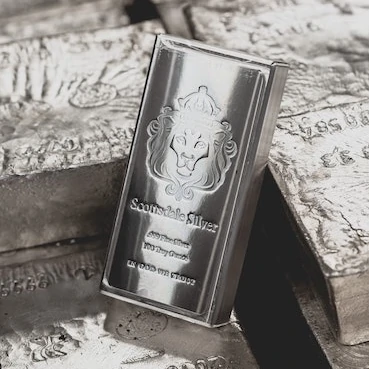Acids And Bases
In this article, we will learn about Acids and Bases. These are the learning outcomes of this article:
- Define an acid.
- Describe the physical properties of an acid.
- Describe the chemical properties of an acid.
This article is written to specifically meet the requirements of the Upper Secondary Chemistry syllabus in Singapore.
What is an Acid?
Acids can be found everywhere around us.
- Citrus fruits such as lemons, grapefruits, and oranges contain citric acid, which gives them their sour taste.
- Vinegar contains ethanoic acid.
- Grape juice contains tartaric acid.
- Even your stomach produces gastric juice that contains hydrochloric acid.
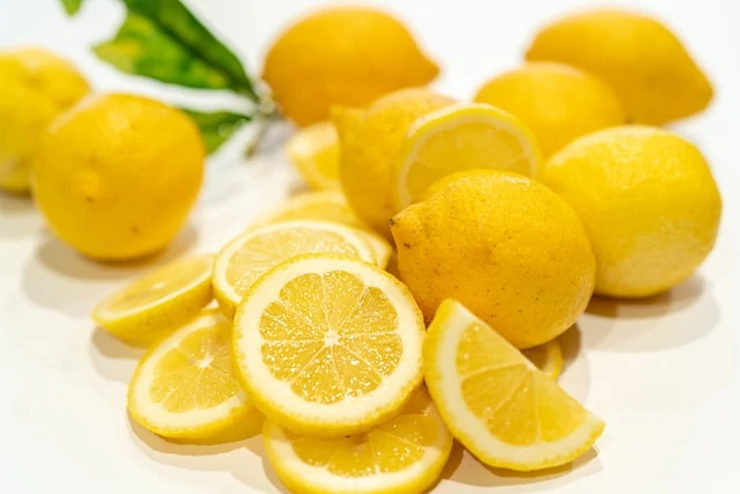
Image Credit: unsplash - eggbank
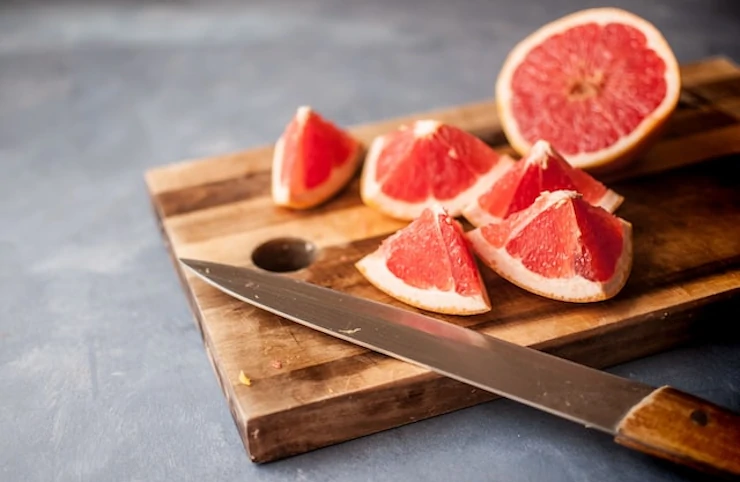
Image Credit: unsplash - Anna Wlodarczyk
Acids can be classified as organic acids and mineral acids. The naturally occurring ones, such as citric acid found in citrus fruits, are organic acids. The other acids, which are man-made, such as sulfuric acid and nitric acid, are mineral acids.
We define an acid as a substance that produces hydrogen ions, H+, in aqueous solution (or when it is dissolved in water).
For example:
\(\begin{align*} \small \textsf{hydrochloric acid} &\xrightarrow[\quad]{} \small\textsf{hydrogen ion + chloride ion} \\[2ex] \small\mathsf{HCl \,(aq)} &\xrightarrow[\quad]{} \small\mathsf{H^{+}(aq) + Cl^{-}(aq)} \\[4ex] \small \textsf{nitric acid} &\xrightarrow[\quad]{} \small \textsf{hydrogen ion + nitrate ion} \\[2ex] \small\mathsf{HNO_3 \,(aq)} &\xrightarrow[\quad]{} \small\mathsf{H^{+} (aq) + NO_3^{-}(aq)}\\[4ex] \small\textsf{sulfuric acid} &\xrightarrow[\quad]{} \small\textsf{hydrogen ion + sulfate ion} \\[2ex] \small \mathsf{H_2SO_4(aq)} &\xrightarrow[\quad]{} \small \mathsf{2H^{+}(aq) + SO_4^{2-}(aq) } \end{align*} \)
It is the hydrogen ions produced that are responsible for the properties of acids.
Do note that not all the substances that contain hydrogen are acids. For instance, water, H2O and ammonia, NH3 contain hydrogen, however, they are not acids. This is because they do not produce hydrogen ions, H+, in an aqueous solution (or when dissolved in water).
Physical properties of Acids
- Acids have a sour taste.
- Acids dissolve in water to form solutions which conduct electricity. The reason for acids to conduct electricity is due to the presence of mobile charged particles, which are the hydrogen ions, H+.
- They turn blue litmus paper red.
- They have a pH value less than 7.
Question 1:
Which representation of dilute sulfuric acid is correct?
- H2 (aq) + SO42– (aq)
- 2H+ (aq) + SO42– (aq)
- 2H+ (aq) + SO4– (aq)
- H2SO4 (l)
Solution:
(B) 2H+ (aq) + SO42– (aq)
Explanation:
Sulfuric acid is a substance that produces hydrogen ions H+ and sulfate ion SO42–, when dissolved in water.
\(\small\mathsf{H_2SO_4\,(aq) } \;\xrightarrow[\qquad]{}\; \mathsf{ 2H^{+}(aq) + SO_{4}^{2-}(aq)}\)
Question 2:
Which of the following explains why hydrogen chloride can dissolve in water to conduct electricity?
- It ionises to form ions that can move about freely.
- Presence of delocalised electrons.
- The electrostatic forces of attraction between the ions are overcome by water molecules.
- Their ions break free from their fixed positions and are free and mobile.
Solution:
(A) It ionises to form ions that can move about freely.
Explanation:
Acids are substances that produce H+ ions when in an aqueous solution. These H+ ions are mobile charged particles and can move freely. This enables acids to conduct electricity.
Chemical properties of Acids
1. Acids react with reactive metals to form a salt and hydrogen gas.
\(\small\textsf{metal + acid} \;\xrightarrow[\qquad]{}\; \textsf{salt + hydrogen}\)
For example, when a piece of sodium metal is added to dilute hydrochloric acid, bubbles of hydrogen gas can be observed. Sodium chloride is the salt produced.
Word Equation:
\(\small\textsf{sodium + hydrochloric acid(D)} \xrightarrow[\quad]{} \textsf{sodium chloride + hydrogen}\)
Chemical Equation:
\(\small\mathsf{2Na\,(s) + 2HCl\,(aq)} \xrightarrow[\quad]{} \mathsf{2NaCl\,(aq) + H_2(g)}\)
So, how do we deduce the chemical name of the salt in the reaction?
Take a look at the following reactions:
\(\begin{align} \small{\textsf{sodium + hydrochloric acid}} &\xrightarrow[\quad]{} \small \textsf{sodium chloride + hydrogen}\\[2ex] \small \textsf{magnesium + sulfuric acid} &\xrightarrow[\quad]{} \small\textsf{magnesium sulfate + hydrogen}\\[2ex] \small \textsf{zinc + nitric acid} &\xrightarrow[\quad]{} \small \textsf{zinc nitrate + hydrogen} \end{align}\)
Notice that the name of the salt is derived from both reactants.
A salt is an ionic compound. Hence, its name must contain a cation and an anion. The cation (positively charged ion) is contributed by the reactant that contains the metal in the reaction.
The anion (negatively charged ion) is contributed by the acid.
- Nitric acid \(\xrightarrow[\quad]{}\) nitrate ion (NO3–)
- Sulfuric acid \(\xrightarrow[\quad]{}\) sulfate ion (SO42–)
- Hydrochloric acid \(\xrightarrow[\quad]{}\) chloride ion (Cl–)
Test for Hydrogen Gas
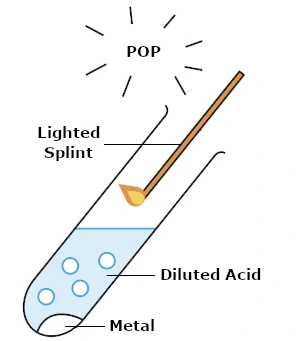
We can test for the hydrogen gas produced by placing a lighted splint at the mouth of the test tube containing the reaction mixture.
Hydrogen gas extinguishes the lighted splint with a ‘pop’ sound.
Are there metals that do not react with acids?
Yes, there are metals that do not react with acids. Unreactive metals such as copper, silver, and gold are examples of metals that show no reaction when added to dilute acids.
|
Image Credit: unsplash - laura adai |
Image Credit: unsplash - Scottsdale Mint |
|
Image Credit: unsplash - Jingming Pan |
|
Lead metal, too, appears to not react with dilute hydrochloric acid and dilute sulfuric acid. The initial reaction of lead with dilute hydrochloric acid or dilute sulfuric acid produces an insoluble salt, which is lead(II) chloride or lead(II) sulfate. This insoluble salt forms a layer to coat around the lead metal, hence inhibiting it from further reaction with the acid.
(*The solubility of salt will be covered in the topic of Salts later)

2. Acids react with carbonates to form salt, carbon dioxide, and water.
\(\small \textsf{carbonate + acid} \xrightarrow[\quad]{} \textsf{salt + water + carbon dioxide}\)
For example, when sodium carbonate is reacted with dilute hydrochloric acid, sodium chloride, water, and carbon dioxide will be produced.
Word Equation:
\(\begin{align} \small\textsf{sodium carbonate + hydrochloric acid(D)} &\xrightarrow[\quad]{} \small\textsf{sodium chloride}\\ & \qquad\qquad+ \\ & \qquad\small\textsf{carbon dioxide}\\ & \qquad\qquad+ \\ & \qquad\;\;\quad \small\textsf{water} \end{align}\)
Chemical Equation:
\(\small \mathsf{Na_{2}CO_{3}(s) + 2HCl\,(aq)} \xrightarrow[\quad]{} \mathsf{2NaCl\,(aq) + CO_{2}\,(g) + H_{2}O\,(l)}\)
Test For Carbon Dioxide
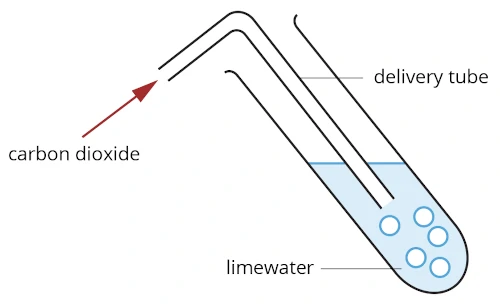
Bubble the gas produced through limewater.
Carbon dioxide forms a white precipitate with limewater.
3. Acids react with metal oxides and hydroxides to form salt and water.
\(\small\textsf{metal oxide / hydroxide + acid} \;\xrightarrow[\quad]{}\; \textsf{salt + water}\)
This reaction is also known as a neutralisation reaction.
For example, when sodium hydroxide reacts with dilute sulfuric acid, sodium sulfate, and water will be produced.
Word Equation:
\(\small\textsf{sodium hydroxide + sulfuric acid(D)} \;\xrightarrow[\quad]{}\; \textsf{sodium sulfate + water} \)
Chemical Equation:
\(\small \mathsf{2NaOH\;(aq) + H_{2}SO_{4}\;(aq)} \;\xrightarrow[\quad]{}\; \mathsf{Na_{2}SO{4}\;(aq) + 2H_{2}O\;(l)}\)
For example, when iron(III) oxide reacts with dilute nitric acid, iron(III) nitrate and water will be produced.
Word Equation:
\(\small\textsf{iron(III) oxide + nitric acid(D)} \;\xrightarrow[\quad]{}\; \textsf{iron(III) nitrate + water}\)
Chemical Equation:
\(\small \mathsf{Fe_{2}O_{3}(s) + 6HNO_{3}(aq)} \;\xrightarrow[\quad]{}\; \mathsf{2Fe(NO_{3})_{3}(aq) + 3H_{2}O(l)}\)
Role of water in Acids
What happens when acids dissolve in water?
Acids only display their properties when they are dissolved in water. This is because acids dissociate in water to produce hydrogen ions, which are responsible for the acidic properties.
The hydrogen ions produced allow acids to react with metals, carbonates, or metal oxides/hydroxides.
For instance, when hydrogen chloride is dissolved in water, it can react with magnesium. However, when hydrogen chloride is dissolved in an organic solvent, it does not dissociate to produce hydrogen ions. Hydrogen chloride exists as covalent molecules. Hence there is no reaction with magnesium.
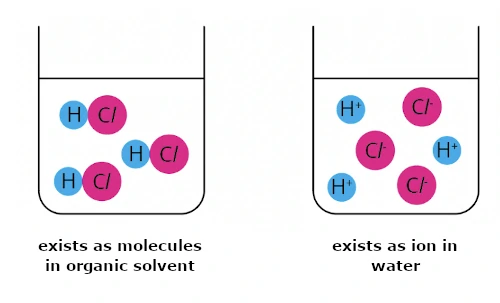
Question 3:
Zinc and zinc carbonate react with dilute hydrochloric acid. How are these reactions the same?
- A gas is produced.
- Only one reaction produces a salt.
- Neutralisation has occurred.
- Water is produced.
Solution:
(A) A gas is produced.
Explanation:
When a reactive metal, such as zinc, reacts with a dilute acid, a salt, and hydrogen gas will be produced.
When a carbonate, such as zinc carbonate, reacts with a dilute acid, a salt, carbon dioxide, and water will be produced.
Question 4:
When a solid was added to sulfuric acid, the solid dissolved and effervescence was observed. Which of the following could not be the identity of the solid?
- ammonium chloride
- magnesium powder
- silver carbonate
- sodium carbonate
Solution:
(A) ammonium chloride
Explanation:
When a reactive metal, such as magnesium, reacts with dilute sulfuric acid, a salt, and hydrogen gas will be produced. Hence, effervescence will be observed.
When a carbonate, such as silver carbonate or sodium carbonate, reacts with dilute sulfuric acid, salt, water, and carbon dioxide will be produced. Hence, effervescence will be observed.
When ammonium chloride is added to dilute sulfuric acid, no gas is produced. Hence, no effervescence will be observed.
Conclusion
In the article, we learned about the definition of an acid and studied the physical and chemical properties of acids.


 SG
SG  VN
VN 

